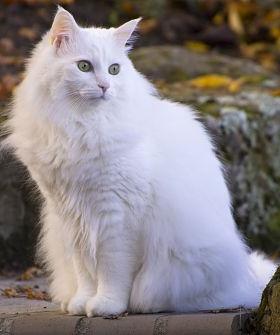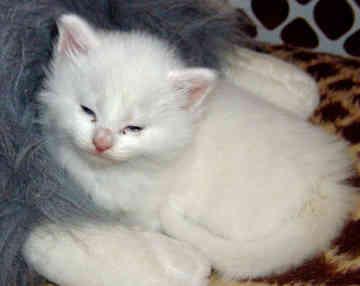In the Muslim East, cats have special respect. This is the favorite animal of Mohammed. But what breed did the kitty belong to, whose sleep was so afraid of disturbing the prophet that he chose to cut off the sleeve of his robe? The Iranians claim that the Persian, and the inhabitants of the former Ottoman Empire believe that it was a Turkish Angora. Cat breed, named after the city of Ankara (in ancient times it was called a little differently), it is mentioned in notes of Western travelers from the 15th century.

In the 16th century, the philanthropist Pietro Della Vale made an unsuccessful attempt to breed two of these cats for breeding in Italy. In the XVII and XVIII centuries, angora became very fashionable at the courts of Richelieu and Marie Antoinette. But the “Persian boom” that followed then mixed both breeds. The restoration of Angora was laid by the Germans in the 1920s in Nuremberg. With purely Germanic meticulousness, they described the characteristics of the breed and later adopted the standard. In Russia, Turkish Angora appeared long ago, but the peak of its popularity fell on the Russian-Turkish war. The imperial favorite, Prince Potemkin, presented Catherine II with two “trophy” cats. By the way, in the homeland of Angora there was a time when the breed was almost washed out. So the Turkish authorities issued a decree on breeding individuals at the zoos of Ankara and Istanbul.

Now about the animals themselves. What kind of cat is this - Turkish Angora? The animal is small, very graceful. It moves as if dancing on fluffy pointe shoes. There are many breeds of long-haired cats in the world, but the Angora fur coat is special - it is of medium length over the body, and on the neck, “panties” and tail like a wavy fleece. Moreover, only the outer hair is present, without the slightest undercoat! The natural grace of Turkish women is only emphasized by long legs with round pads, a small pointed muzzle and large ears. Despite its modest size, her muscles are well developed: her body, like that of a real ballerina, is slender, toned.
In Russia, it is believed that the real Turkish Angora It should be snowy white, but it’s not. In fact, the standard allows a wide variety of colors: cream, blue, red, black. And also their derivatives: “smoke”, “chintz”, “tabby”. The main thing is that the color should be one, without impurities, and the nose and paw pads should be in tone with the main suit. As for the color of the eyes, then in Turkey, the Ankara Cadie is most appreciated: one cat's eye should be blue, and the second orange. But this is a tribute to the "Father of all Turks" Ataturk, who, as you know, also had eyes of different colors.

White cats with blue eyes are fashionable in Russia, although such individuals quite often suffer from deafness. Because of this defect, it is forbidden in the West to cross two white Angora together, because under this mating, underdeveloped and deaf kittens are born 100%. Turkish Angora is also susceptible to yet another inherent disease: ataxia. Do not neglect the large percentage of the probability of feline hypertrophic cardiomyopathy. But basically this breed is included in the list of centenarians.
Turkish Angora is an active, intelligent and curious cat. As a rule, she chooses one member of the family whom she considers to be the real owner. If your priority is an impeccable order in the house, then you should choose an animal of a different breed. It’s as if the batteries from the Durasel are inserted into the angora - it is ready to rush around and mess out from morning to evening. Her voice is melodic, and she often communicates with the owners. Due to the lack of fluff, hair care is not a problem.